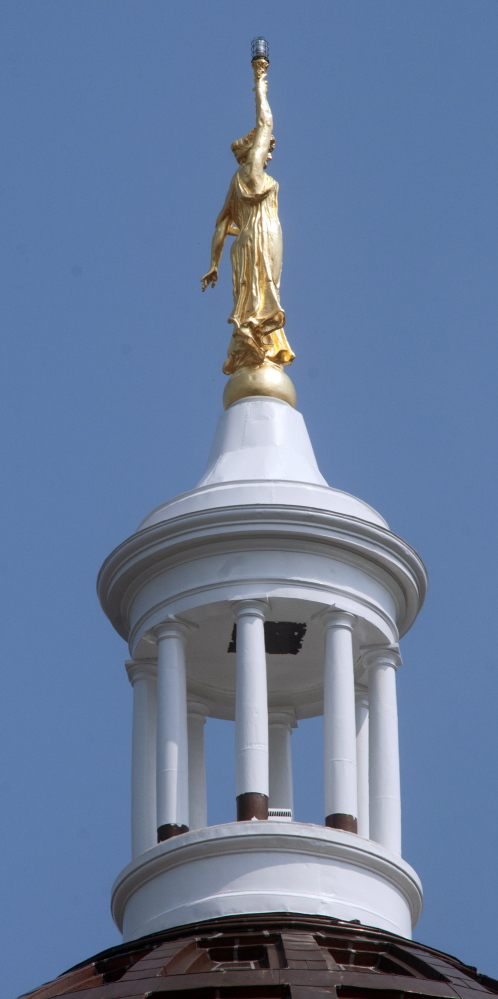Some of the century-old, patina copper removed from the Maine State House dome last year may be available to the public as soon as next month, while plans are still underway to commission the construction of a sculpture with the copper somewhere on the capitol grounds in Augusta.
The state is producing a couple of commemorative keepsakes using the century-old copper sheathing and will make a large portion of the copper available for purchase.
Meanwhile, work is being done to repaint parts of the new copper where the white paint didn’t hold, according to Grant Pennoyer, executive director of Legislative Council, which approved the copper reuse plan. That work is being redone at not cost to the state because it didn’t meet the guarantees in the contract, he said.
The original $1.3 million plan to restore the dome, including the cupola and its 12-foot-tall Lady of Wisdom statue on top, called for the state to hold onto 500 square feet of the 7,000 square feet of greenish, oxidized copper, but lawmakers later approved a plan to buy back all of the copper for souvenirs, public sale and sculptures on the capitol complex after receiving inquires from artists and members of the public interested in the copper.
The council of legislative leaders is expecting to release a notice about the availability of the copper next month.
Pennoyer said it’s not yet known how much plan to use the copper for souvenirs and public art will cost. Because the majority of the copper was originally slated to be sold as scrap to offset the cost of the project, some of the uses for the copper will end up netting the state less money.
A cost estimate for the proposal approved by the Legislative Council last September said it would cost about $42,000, but plan is now to commission only one public art piece, not two, Pennoyer said. That is the most expensive proposed use of the copper, previously estimated to cost $26,750 for the two pieces.
Other uses, including selling pieces to artists and the public, were expected to bring in more money.
The commemorative souvenirs planned are a plaque with a 2-inches square piece of the copper and an aerial photo of the work being done with a piece of the copper, Pennoyer said. They’ll likely be available for purchase through the Legislative Council’s website, he said.
The state replaced the copper and restored the dome last year because holes had formed in the copper sheathing, allowing water in. The project, funded by the Legislative Council, received a 2014 Maine Preservation honor award for the restoration of a historic landmark. The work done by the contractor, Consigli Construction, also included adding new LED lights in the statue’s torch.
The project produced a starkly different-looking dome when completed in November. Before being replaced, the copper on the dome, which was built as part of a 1909-1910 expansion of the capitol building, had become light green as a result of more than century of exposure to oxygen. The new copper shined like a new penny when first installed and has since dulled slightly.
It won’t regain that greenish patina for at least another few decades.
The well-worn, patina nature of the old copper was one of the draws for artists interested in using it for jewelry, sculptures or other projects.
Julie Richard, executive director of the Maine Arts Commission, which is working with the Legislative Council and helped put together the proposal for reusing the copper, said some of it is pretty beaten up, but there are some nice verdigrised copper pieces that could be constructing into something really interesting.
“Some artists work exclusively in copper or metal, so this really is a chance to highlight the metal artists of Maine and create a lasting piece that will hopefully live on forever on the State House grounds,” she said.
There isn’t a timetable for the development of the public sculpture, and the amount of copper that will set aside for it isn’t yet known, Richard said.
She said the process for choosing an artist will be similar to the commission’s Percent for Art public artwork program. A committee will chose finalists after putting out a call for artists, the finalists will present their proposed designs to the committee and the committee will chose the final project.
Richard said she doesn’t yet know when the commission will put out the call for artists.
Send questions/comments to the editors.




